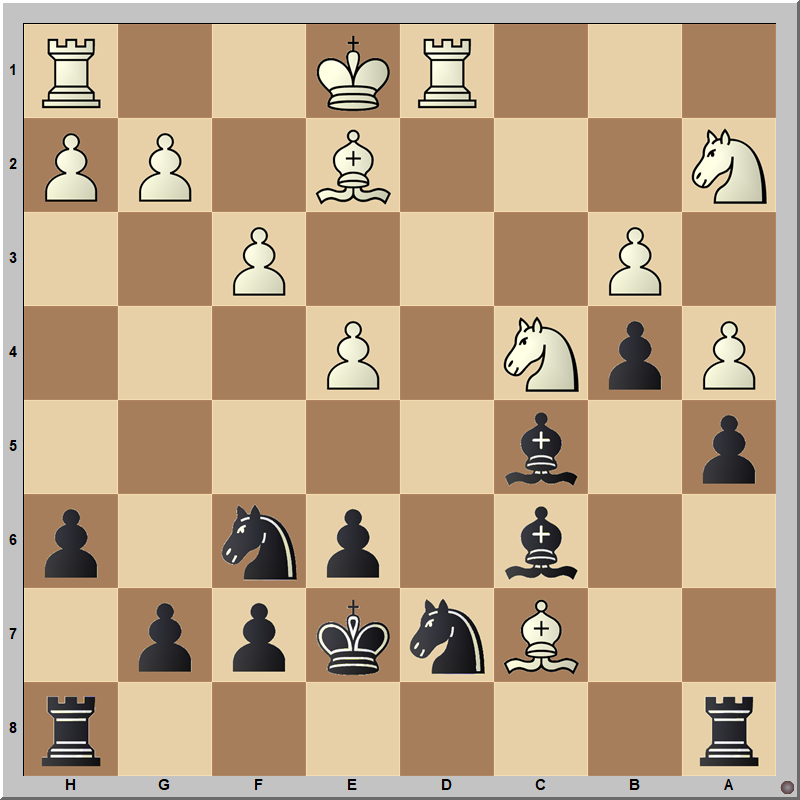Recapping February's Tournament (Part 2)
The second half of my tournament in Dallas, TX
Catch up on part one of February’s tournament here
Picking up after the previous blog post, we are now going to be looking at the final four games of the Southwest Class Championship. In the first half I started with 4/5 (one loss to a GM then four wins in a row). Let’s see how rounds 6-9 went!
Round 6: White vs Brodsky, David (2506 FIDE - Grandmaster)
Here Black has just played 11…cxd4 and I have a few options: 12. cxd4, 12. Nxd4 or 12. axb5. I ended up misevaluating things here and went for 12. axb5?! which is probably the worst of the three captures. Originally I wanted to play 12. cxd4! but was bothered by 12…Rc8 13. Bd3 Qxc1 14. Rxc1 Rxc1+ 15. Ne1 0-0 and thought Black was in good shape due to my pinned pieces on the first rank. In hindsight though this position is simply good for White after 16. axb5.
After 12. axb5?! dxc3 13. Nxc3 axb5 14. Nxb5 Qb8 15. Rxa8 Bxa8 it ends up that my pieces don’t have great squares while Black has the better pawn structure and slight advantage already. Brodsky went on to win the game convincingly later.
Round 7: Black vs Mikaelyan, Arman (2508 FIDE - Grandmaster)
White has just played 22. Bc7 attacking our a5-pawn. What to do?
I found the correct sequence of moves to turn the game in my favor: 22…Ra7! 23. Bxa5 Rb8 and white’s bishop is now a bit trapped. After 24. Rc1 Ba8 25. Rc2 Ne8! (aiming for …Nd6 to trade off the c4-knight which is defending the a5-bishop) 26. Rd2 f6! (now going for …Ne5 to trade off the c4-knight) 27. Kd1 Ne5 28. Nxe5 fxe5 29. Bxb4 Bxb4 30. Nxb4 Rxb4 I end up being ahead a piece for two pawns with a winning advantage. The game ended up being drawn later unfortunately. This would have been a really nice game to win and it was entirely possible to do so.
Round 8: Black vs Chasin, Nico (2455 FIDE - International Master)
After a chaotic middlegame we reached this tricky position. I have an extra piece but Black has two extra pawns. My knight is also very far from the center and my king is very exposed. Black has a big threat of …Rf4-g4. How to deal with this?
I found the best move 42. Qd1! which is the best response. I defend my pieces while offering a queen trade. After 42…Qc6 43. Re3 Rf4 44. Nc3 Qc5 45. Qd3 I have finally consolidated my position and have the advantage. Despite this, the game was also drawn later after some inaccuracies in time trouble. Another missed win.
Round 9: Black vs Wang, Jason (2453 FIDE - International Master)
We arrive at a position from the Queen’s Gambit Declined with the typical Carlsbad pawn formation. White has just played 24. b4. How to play as Black?
The typical plan here is to play for a kingside attack while White plays for a queenside minority attack. With that in mind 24…g5! was a good start. However, after 25. Qd1 I started to go wrong though with 25…Qg6?!. Better would have been 25…Ng7 with the idea to push …h5 next and keep the pawn storm going. I ended up not playing the kingside attack correctly while White did indeed get good queenside play going. I eventually lost this game later on.
So that does it for this tournament! Since this was a 9-rounder here’s the norm update: I ended up scoring 5/9 for a performance rating of 2404 which is the rating level for an International Master. However, in order to get an International Master norm you need to have a performance rating of 2450. If I had won my last round game then my performance would have been 2486 which would have gotten me the norm. So close! Maybe it’ll come in a future tournament :-)
February ended with a 25-point USCF gain (2325 → 2350) and an 44-point FIDE gain (2182 → 2226) which is a great improvement from one tournament. It was also good to see that even with a great tournament there were still points left on the table (two draws that could have been wins!) which is usually a good sign.
My next upcoming tournament should be the Southern Class Championship in Orlando, Florida (my old hometown area!) during the middle of March. If any readers happen to play in that tournament then feel free to find me and say hello!
Until next time!





